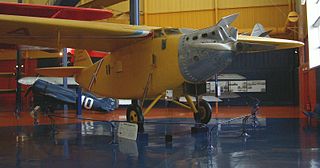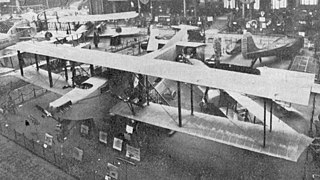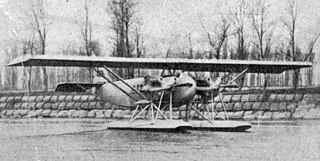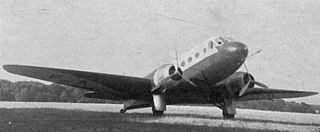
The Ilyushin Il-18 is a large turboprop airliner that first flew in 1957 and became one of the best known Soviet aircraft of its era. The Il-18 was one of the world's principal airliners for several decades and was widely exported. Due to the aircraft's durability, many examples achieved over 45,000 flight hours and the type remains operational in both military and civilian capacities. The Il-18's successor was the longer-range Ilyushin Il-62.

The Focke-Wulf Fw 58 Weihe (Harrier) was a twin-engine multi-role aircraft designed and produced by the German aircraft manufacturer Focke-Wulf.
The Aero A.204 was a Czechoslovak airliner that flew in prototype form in 1936. It was developed specifically for ČSA, but much to Aero's surprise and disappointment, the national airline selected a British product instead, the Airspeed Envoy. Unable to find a customer, Aero began to develop a military version instead, as the A.304.

The Farman F.220 and its derivatives were thick-sectioned, high-winged, four engined French monoplanes from Farman Aviation Works. Based on the push-pull configuration proven by the F.211, design started in August 1925 and the first flight of the prototype was on 26 May 1932. The largest bomber to serve in France between the two world wars was the final F.222 variant. One variation was intended to be an airliner.

The Beriev Be-30 is a Russian regional airliner and utility transport aircraft designed by the Beriev Design Bureau. It was developed specifically for Aeroflot local service routes using short, grass airstrips. It was also designed to be used in the light transport, aerial survey and air ambulance roles. It competed against the Antonov An-28 and the Czechoslovakian LET-410.

The Beriev MBR-2 was a Soviet multi-purpose flying boat which entered service with the Soviet Navy in 1935. Out of 1,365 built, nine were used by foreign countries. In the Soviet Union, it sometimes carried the nickname of "Kорова" (cow) and "Амбар" (barn).

The PZL.44 Wicher (gale) was a prototype of 14-seat, twin-engine Polish airliner, built in the Państwowe Zakłady Lotnicze (PZL) in 1938. It was to compete with the DC-2 and Lockheed Super Electra.

The Bernard 190 or Bernard-Hubert 190 was a French airliner of 1928. It was a high-wing cantilever monoplane of conventional configuration, based on the Bernard 18. Compared with its predecessor, it kept the same basic design but featured redesigned tail surfaces, an enlarged cabin, and offered its flight crew a completely enclosed cockpit. Also like its predecessor, the basic airliner model provided the basis for a long-range aircraft to be used in record attempts, the 191GR.
The Dassault M.D.320 Hirondelle was a French 14-seat utility transport aircraft of the 1960s, designed and built by Dassault Aviation, in prototype form only.

The Caudron C.61 was a French three-engined civil transport biplane aircraft built by the French aeroplane manufacturer Caudron. It was constructed of wood and covered in fabric.

The Farman F.170 Jabiru was a single-engine sesquiplane airliner designed and built by the French aircraft company Farman Aviation Works. It is a derivative of the F.121 Jabiru.

The Fairchild 91,, was a single-engine eight-passenger flying boat airliner developed in the United States in the mid-1930s.

The Fokker F.XIV was a cargo plane built in the Netherlands in the late 1920s by Fokker. It was a high-wing cantilever monoplane of conventional trimotor layout. The sole example was tested by KLM but never put into service.

The Latécoère 15 was a French airliner built in 1925 for Latécoère's own airline, which operated routes between France and Morocco. It featured a parasol-wing monoplane design with twin engines mounted on the wing bracing struts. Small stub wings on the lower fuselage provided mounting points for the struts and main undercarriage units. The aircraft could carry six passengers in an enclosed cabin, while the pilot was situated in an open cockpit at the nose.

The Renard R.35 was a prototype pressurised airliner of the 1930s built by the Belgian aircraft manufacturer Constructions Aéronautiques G. Renard. A three-engined low-winged monoplane with retractable undercarriage, the R.35 was destroyed in a crash on its first flight.
The Nord 2100 Norazur was a 1940s French military transport monoplane designed and built at Courbevoie near Paris by SNCAN.
The Jurca MJ-53 Autan is a plans-built, low-wing, touring monoplane designed in France by Marcel Jurca.
The Bernard 80 GR was one of three types built by different French constructors in response to a government call for an aircraft capable of setting new long-distance records. A single engine monoplane with a crew of two, the 80 GR set an absolute record for flight over a closed circuit in April 1931, covering 8,960 km (5,569 mi). Modifications led to a new designation as the Bernard 81 GR but no more records were set despite several attempts.

The Caudron C.74 was a ten-seat, four engine passenger biplane built in France in 1922. It showed promise but the sole prototype crashed fatally in a competition and no more were completed.

The Bréguet 670, Bréguet 670T or Bréguet-Wibault 670 was a French twin engine, all metal eighteen seat airliner with a retractable undercarriage flown in 1935. Only one was built.
















